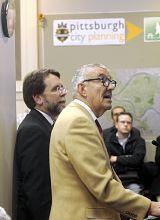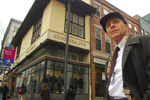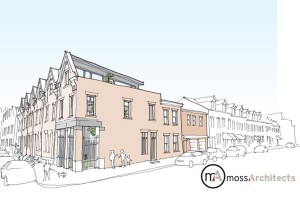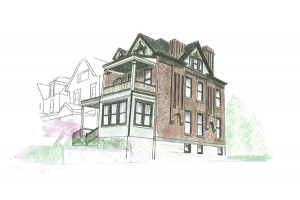
Latest News
-
Civic Arena a ‘Symbol of Genocide’
By Bill Vidonic
PITTSBURGH TRIBUNE-REVIEW
Thursday, February 3, 2011Former City Councilman Sala Udin was among the 8,000 residents and businesses in the lower Hill District who were displaced in the 1950s for construction of the Civic Arena.
On Wednesday, he urged Pittsburgh’s Historic Review Commission to reject a push to grant the arena protection under the city’s historic structure preservation law.
“This is more a symbol of genocide than a historic icon,” Udin said. “Demolish the arena and let the promise begin.”
During more than four hours of testimony, preservationists said that the arena’s distinct domed shape, its engineering and its place in the fabric of Pittsburgh’s history should spare it from a wrecking ball.
The city-county Sports and Exhibition Authority, which owns the building, and city Planning Commission have voted to demolish the building. The SEA had hoped to start in April, but the nomination for historic status has delayed that.
“There’s nothing like it anywhere else,” said Eloise McDonald of the Hill District, one of the people who nominated the structure in November. “That’s what makes it historical.”
Franklin Toker, a University of Pittsburgh art and architecture professor, said development and construction of the arena in the 1950s and ’60s coincided with “the most exhilarating, most creative and most ambitious moment this city has ever known: the Pittsburgh Renaissance.”
“It is the branding image for Pittsburgh, right under our noses,” Toker said.
A 2007 agreement between the Sports and Exhibition Authority and the Pittsburgh Penguins gave the sports franchise development rights for the 28-acre site.
Various representatives outlined a long-term redevelopment plan — one in which the arena is leveled — to make way for residential, retail and commercial development, creating thousands of jobs and millions of dollars in tax revenue.
City Councilman R. Daniel Lavelle, who represents the Hill District, said there’s no redevelopment plan for the arena itself.
“The hard truth is that the Civic Arena remains a symbol of failed public policy and a continual deterrence to economic viablility for the Hill District community. Historic designation and preservation, for many reasons, is not the correct decision. On the contrary, what might be more appropriate at this time is an apology for the historic injustices that were heaped upon the Hill District when it was torn asunder nearly a half-century ago.”
The city rejected historic status for the structure in 2002. The Historic Review Commission could make a recommendation next month; the city’s Planning Commission and City Council still must consider the request, a process that likely will stretch into summer.
-
Demolition of Iron City Ice House OK’d
Thursday, February 03, 2011Pittsburgh Post-GazetteThe Historic Review Commission Wednesday approved demolition of the original ice house at the Iron City Brewing Co. in Lawrenceville, one of a collection of buildings on the site that has the city’s protection of historic status.
The one-story building, which sits behind the original brewhouse, is dilapidated. Brewery CEO Tim Hickman said he would not consider an estimated $750,000 it would take to restore it.
Acting commission chair Ernie Hogan said that the Pittsburgh Historical and Museum Commission and a preservation planner advised the commission that if the building is properly documented it can be demolished without jeopardizing the rest of the site’s potential for placement on the National Register of Historic Places or the tax credits that would go with its redevelopment.
Preservationists argued against any demolition at the brewery site before completion of a master plan.
The commission also approved demolition of an unused garage in Deutschtown, to be replaced by a new Duquesne Light valve station, with pipes and conductors beneath it. The original plan to build the station in Allegheny Commons Park was abandoned after strong neighborhood outcry.
-
Fate of Civic Arena Debated
Panel considering historic designation for Hill landmarkThursday, February 03, 2011By Mark Belko, Pittsburgh Post-Gazette
John Oyler, right, an engineer, talks Wednesday about how important the Civic Arena is as an example of structural engineering because it was done in the days before computer design. Speaking before the Historic Review Commission, he described how remarkable and unique the retractable dome is. Larry Roberts/Post-Gazette
To those who want to see it saved, the Civic Arena is an engineering marvel, an irreplaceable icon and a testament to Pittsburgh know-how.
But to those who want to see it go, the arena is “more a symbol of genocide” than a civic treasure, an aging relic with bad pipes, lousy acoustics and high maintenance costs.
So it went for more than four hours Wednesday during a public hearing before the Pittsburgh Historic Review Commission to determine whether the 49-year-old landmark should be designated as a city historic structure.
The commission, in a 5-1 vote last month, already gave preliminary approval to the designation, which would prevent the city-Allegheny Sports & Exhibition Authority from demolishing the building as part of a plan by the Pittsburgh Penguins to redevelop the site.
It is scheduled to take a final vote next month. Preliminary approval is no guarantee the arena will survive. In 2002, the panel gave similar approval to the designation only to reject it in a final vote.
Perhaps that’s the reason the nominator, Hill District resident Eloise McDonald, backed by Preservation Pittsburgh and Reuse the Igloo, and the SEA and the Penguins each spent more than an hour Wednesday advancing their arguments for or against designation.
Ms. McDonald and her allies believe the arena meets six of the 10 criteria that make a structure worthy of designation, including its location as a site for significant historic events, its exemplification of a rare, unique or innovative architectural style, and its unique location and distinctive physical appearance.
Only one of the 10 must be met to get a designation.
Franklin Toker, an architecture professor and the author of “Pittsburgh: A New Portrait,” argued that the arena “is, historically, the most representative building now standing in the city of Pittsburgh,” more so than the Cathedral of Learning, the county courthouse or the David L. Lawrence Convention Center.
He said the arena’s planning and construction “coincided exactly with the most exhilarating, most creative and most ambitious moment this city has ever known: the Pittsburgh renaissance.”
Others cited the arena’s retractable dome, one of the few in the world, or the engineering that made it work as reasons the old building should be saved.
Shawn Gallagher, the SEA’s attorney, said the agency doesn’t believe the arena meets even one of the 10 criteria for nomination.
He and others who support demolition said the arena requires millions of dollars in capital improvements, doesn’t meet accessibility standards and has no viable future as an entertainment venue.
“It clearly is not worthy of preservation,” Mr. Gallagher said.
City Councilman R. Daniel Lavelle said the arena, for many in the Hill, represents failed public policy, one that destroyed homes and businesses and displaced thousands of residents.
“This is not the sort of history we wish to preserve,” he said.
The hearing drew a number of other Hill residents who made similar comments, including former city Councilman Sala Udin, who said the arena is “more a symbol of genocide than a historic icon.”
And while some remember favorite concerts or exciting hockey games when they go into the arena, Hill resident Angela Howze recalls something else.
“Every time I go in there I remember it once was my grandmother’s house,” she said.
-
Iron City Allowed to Raze Building
By Bill Vidonic
PITTSBURGH TRIBUNE-REVIEW
Thursday, February 3, 2011The city’s Historic Review Commission will allow the president of Iron City Brewing Co. to tear down a dilapidated building at its former Lawrenceville production site.
The commission on Wednesday said Tim Hickman should provide it with photographs and other documentation of the 1,900-square-foot building for its records, but otherwise can proceed.
The city’s Bureau of Building Inspection cited the brewing company because of the distressed state of the building, but the site’s historic status — granted by the city last year — had complicated the issue of razing the building.
Commission acting chairman Ernie Hogan said state officials indicated that tearing down the former pipe shop shouldn’t interfere with the historic status or development tax credits. Hickman said the site could be developed for light industrial use and industrial warehousing.
Iron City moved production from Lawrenceville to Latrobe in 2009.
Hickman will have to talk to the commission next month about taking fermentation tanks out of another building. Hickman proposed removing two walls to do so; he said the building is useless with the tanks inside.
Also, Hickman has an agreement with the Pittsburgh Water and Sewer Authority to use the proceeds of the tanks’ sale to settle a billing dispute dating to 2007.
-
Row of Vacant Lawrenceville Houses Being Restored with Historic Exteriors, Custom Interiors
Wednesday, February 02, 2011
Pop City Media
Since they were left vacant in 1995, the row of five historic brick houses on 48th Street, between Hatfield and Butler Streets, in Lawrenceville have fallen into terrible shape. With creative design and green construction, the homes are being restored to look the way they would have when they were built in the 19th century, but with customized modern interiors.
The City of Pittsburgh acquired the buildings, with the help of the Lawrenceville Corporation, in 2007 at very low cost using a tax lien process. After receiving proposals from many eager developers, the Lawrenceville Corporation closed on the sale last week with Botero Development, who’s principal Brian Mendelssohn lives in the neighborhood.
“They’re going to be a high quality product. We’re going to restore the exteriors using real materials, meaning real stone and real slate, and install stone steps and things like that to make them look like when they were built,” says Mendelssohn, who is working with Moss Architects on the project. The interiors will be custom-built for the aesthetic whims of the individual buyers, blending historic elements and original materials with modern features, such as stainless steel appliances, and energy efficient design aspects, like a 2-inch white rubber roof.
The homes, which are currently for sale, include four 1900-square-foot, 3-bedroom units with rear yards. Two come with 2.5-baths and the other two have 2-baths. One 1,250-square-foot unit has 2-bedrooms and 2-baths. The houses will be completed by next October and are priced between $180,000 and $265,000. A sixth building was beyond repair, but its lot will serve as a private courtyard for the $265,000 unit.
“I feel the prices are below market value for what these buildings are,” says Mendelssohn. “It will be good for the neighborhood not to start charging $300,000 for homes in Lawrenceville. You don’t want to gentrify your own neighborhood, you want to keep it what it is.”
Writer: John Farley
Source: Brian MendelssohnImage courtesy of Botero Development
-
$10 Million PHLF Redevelopment Projects Restore Three Homes and Create 27 Apartments in Wilkinsburg
Wednesday, February 02, 2011
Pop City Media
When Pop City last reported on The Pittsburgh History and Landmarks Foundation‘s Wilkinsburg redevelopment projects in 2008, four homes in the Hamnett Place neighborhood had successfully been restored. The PHLF recently announced that three more historic Hamnett Place houses, as well as the two-building, 27-unit Crescent Apartment development, are scheduled for completion by fall of 2011.
“It really is one big project because all of these things are kind of interlinked. We also launched a housing resource center in the same area last year and we’ve done a lot of cleaning and vacant lot work around the area. There are a lot of initiatives happening right now in Wilkinsburg that total over $10 million,” says Michael Sriprasert, director of real estate for the PHLF.
“Right now the three properties at 833 and 845 Holland Avenue and 517 Jeanette Street have undergone interior demolition and we have begun construction,” says David Farkas, director of main street programs for the PHLF, in regard to the second phase of the Hamnett Place project that began in December. The PHLF received assistance from Allegheny County Economic Development and The Allegheny Foundation for the restoration of these homes, which will have buyer incomes restricted to 120% of the area median income.
The PHLF is 30% finished with the redevelopment of two buildings in the $8.6 million, 27-unit affordable Crescent Apartments, which was funded by The Pennsylvania Housing Finance Agency, Allegheny County’s Office of Behavioral Health, and private sources.
The PHLF worked with architects Landmarks Design Associates on both the Hamnett Place and Crescent Apartments projects, and with Mistick Construction and Sota Construction on the Hamnett Place and Crescent Apartments, respectively.
Writer: John Farley
Sources: Michael Sriprasert and David Farkas, PHLFImage courtesy of PHLF
-
Landmarks Foundation Waits for Word on $4 Million State Grant
By Craig Smith
PITTSBURGH TRIBUNE-REVIEW
Wednesday, February 2, 2011
Arthur Ziegler, president of the Pittsburgh History & Landmarks Foundation, surveys Fifth Avenue, Downtown, part of an area his group has earmarked for more redevelopment like its Market at Fifth project. The foundation is awaiting word on whether a $4 million state grant from former Gov. Ed Rendell's administration will come through. Gov. Tom Corbett is reviewing that grant and others like it. Keith Hodan | Tribune-Review
Arthur Ziegler Jr. likes what he sees Downtown.
Seven apartments and two retailers occupy three historic buildings that were brought back to life through a $3 million Pittsburgh History & Landmarks Foundation project dubbed Market at Fifth. More projects in the area could come to fruition if a $4 million state grant comes through.
“I am very pleased … the momentum is gaining,” said Ziegler, the foundation’s president.
Ziegler hopes to leverage the $4 million grant from former Gov. Ed Rendell to do more historic renovation work. Gov. Tom Corbett, who took office last month, is reviewing the grants, handed out in the final days of the Rendell administration through the state’s Redevelopment Assistance Capital Program, or RCAP.
The money was committed to Pittsburgh for historic building facade and core shell restoration, Ziegler said. The city appointed the landmarks foundation to carry out the work.
“It would be a great project for the city and Downtown,” said Rob Stephany, executive director of the city Urban Redevelopment Authority.
Some leaders criticized Rendell’s use of the RCAP grants, which come from borrowed money. Corbett said before he took office he would review all of the grants Rendell approved at the end of his term.
“We’re trying to go through the RCAPs as quickly as possible to make a decision,” said Kevin Harley, spokesman for Corbett.
Other areas of the country are successfully using historic renovation to spur development.
“We’re seeing a real move back to our center city — businesses and residents,” said Kevin Schwab, vice president of communications for CenterState Corp. for Economic Opportunity in Syracuse, N.Y.
Since the late 1980s, the downtown population has doubled from 1,000 to 2,000 people and 16 of 18 condos near a historic district have been sold, Schwab said. In the past decade, the revitalization has gained momentum, even during the recession, he added.
“It has all been driven by the rehabilitation of buildings that have been deemed historic,” he said.
New buildings are going up “with an eye toward being in concert” with what is already around them, he said.
If the $4 million grant for Pittsburgh survives Corbett’s review, the landmarks foundation plans to augment it with donated funds “so we can really solidify the new quality retailing we introduced with Market at Fifth,” Ziegler said.
“We would like to double (the $4 million),” he said.
The money would be used to renovate a half-dozen historic buildings scattered in the Fifth and Forbes area that have been scheduled for preservation since the days of former Mayor Tom Murphy, Ziegler said.
The Market at Fifth project restored three buildings within the Market Square historic district, including the former Regal Shoe Co., which opened in 1908.
The Regal building was designed by Alden & Harlow, then one of the city’s prominent architectural firms, responsible for the Carnegie Institute and Library additions in Oakland, and Carnegie branch libraries in various communities.
Its chief designer was one of the firm’s principals, Frank E. Alden, who in the late 1800s worked with architect H.H. Richardson supervising construction of noteworthy Downtown buildings such as the Allegheny County Courthouse and the Allegheny County Jail.
-
Praise for PHLF Educational Programs
A Sampling of Comments from the Pittsburgh History & Landmarks Foundation 2010 Education Report
Compiled by interns Allison Ake (Duquesne University) and Lizzy Stoyle (University of Pittsburgh)
“We both agreed that it’s a fabulous program and a perfect enhancement to the 3rd grade Pittsburgh social studies curriculum.” [“Building Pride Building Character Trolley Tour”] Alea Melacrinos, Banksville Elementary School, February 19, 2010.
“Going on these tours makes one feel more connected to the city!” [Free Friday Walking Tours] Susan Karas, April 13, 2010
“Our guide was excellent, catered to everyone in the tour group, and full of useful information. It enhanced my appreciation of Pittsburgh.” [Grant Street and More Tour] Matthew Kessler, May 10, 2010
“That was the best field trip I ever went on and probably the best one I will ever go on.” [“Building Pride Building Character Trolley Tour”] Jimmy L., Pittsburgh Minadeo Student, May 20, 2010
“The guide was very informative and friendly. Thank you for all you and your team do to promote this wonderful city.” [Friday Grant Street Tour] John Kanik, May 24, 2010
“Well-organized, thorough descriptions of our city’s history, student-friendly and fun, knowledgeable educators/docents guiding the trip. Students are able to ride a trolley and visit places they may never have the opportunity to visit!” [“Building Pride Building Character Trolley Tour”] Anonymous Teacher
“Now I don’t call something an “old building.” I say, “Look at the potential that historical building has.” [Westmoreland Design Challenge] Anonymous Student
“A magical blend of history and architecture – the students were in awe!” [Downtown Dragons Tour] Anonymous Teacher, Summer 2010
“Loved by both kids and parents, and extremely educationally valuable.” [Downtown Dragons Tour] Anonymous Teacher, Summer 2010
“I feel that I learned a lot about involving the community in the history, preservation, and arts of our city.” Loraine Ziegler, former intern, August 3, 2010
“PHLF seems like a prefect partner to help underscore the relevance of history!” [CMU Prize in Architectural History] Kai Gutschow, M.Arch/PhD CMU School of Architecture, August 24, 2010
“I may not be the first scholarship recipient to achieve this goal, nor do all go into architecture, but I thought you’d like to know that what began so many years ago as a simple $4,000 scholarship helped me get to where I am today.” [He is a fully-registered practicing architect.] Steven Albert, August 27, 2010
“What he learned is going to make him appreciate his Downtown office environs a lot more.” [Fourth Avenue & Grant Street Tour] Violet Law, September 11, 2010
“This was my first time to Pittsburgh… such a great way to start my visit.” [Car Free Saturday-South Side Tour] Trisha Knueven, October 23, 2010
“Thank you very much for taking your time and providing my students with a trip that really held their interest.” [Downtown Dragons Tour] Mary Beth Veri, Carlynton School District, October 21, 2010
“Every year, I learn something new.” [Urban Survival Tour] Anonymous, Gateway High School, October 27, 2010
“It was so well organized and I felt that the kids were safe and engaged the entire time.” [Urban Survival Tour] Anonymous, Winchester-Thurston, September 20, 2010


